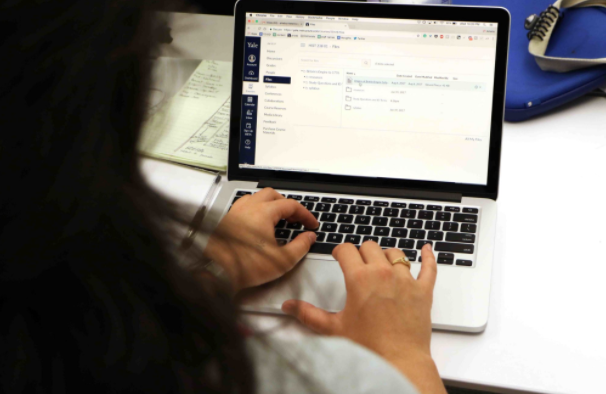*Editor's note: This article is from the student news organization Yale Daily News of Yale University in New Haven, Connecticut. It is republished with permission.
The University’s 18-month transition from the academic server Classes*v2 to Canvas came to quiet conclusion this fall, as all Yale faculty members and students have begun using the new system.
Canvas, which Yale promised would offer a more streamlined and professional user interface than the old system, is being heralded by faculty and students as a vast improvement.
“It’s good to have everything in one place,” said Sam Wood ’20, noting that Canvas has a better design and allows for easy access of course materials. Caroline Schlutius ’18 agreed, noting that learning how to navigate Canvas has been simple.
Yoojin Han ’19 recalled her initial surprise at Yale’s sudden decision to change platforms, but said she prefers Canvas to Classes*v2 now that the change has occurred.
Han went on to list the advantages of Canvas: several features, such as the media library, are useful for the courses she is taking, the interface is effective in organizing readings, announcements and assignment submissions; and the file formats she uses are compatible with Canvas.
“The webpage is easy to maneuver around and it wasn’t a harsh learning curve to get used to Canvas,” Han said.
Deputy Provost for Teaching and Learning Scott Strobel confirmed in an email to the News that the implementation appears to be going well. A Canvas help desk in the Center for Teaching and Learning in Sterling Memorial Library has been established to respond to student and faculty questions.
“We have been pleased with how smoothly the final stage of our implementation of Canvas has been, and students seem happy to have all of their courses now on one platform,” said Pilar Abuin, instructional technology manager at the CTL in an email to the News.
Still, some students interviewed expressed frustration over the transition period last year, in which students and faculty could choose to use either Classes*v2 or Canvas, or both — a situation which often proved confusing.
“I don’t think it was that smooth of a transition because there was a year when some professors were using Canvas and others were using Classes*v2,” said Lane To ’19. “It was not very cohesive, so I think that could have been done a little better.”
But this semester, with all classes finally on Canvas, To expressed satisfaction with the new platform, and noted that there were no aspects of Classes*v2 which they missed.
“We have been pleased with how smoothly the final stage of our implementation of Canvas has been, and students seem happy to have all of their courses now on one platform.”
Ecology and evolutionary biology professor Thomas Near, the head of Saybrook College, agreed with the students’ positive assessment of Canvas, observing that Classes*v2 was clunky and difficult to use, whereas Canvas is much more intuitive. Near said he now regrets having used Classes*v2 for his biology course last year when Canvas was an option. After transitioning to Canvas by necessity this summer, he said he realized he could have accomplished more in his teaching with Canvas.
Near added that he believes the transition has been beneficial for students as well, allowing for more out-of-classroom interaction between faculty and students, and making grading and feedback easier for instructors.
However, while he expressed satisfaction with the transition, Near also voiced concern over the status of intellectual property on Canvas, which is owned and operated by the company Instructure.
“I know one concern is about the ownership of the material that was uploaded to Canvas: whether or not Instructure would then have claim to that material,” he said. “On Classes*v2, because that was a Yale-driven service, the specialized material I produced was still my intellectual property.”
Instructure addresses this concern on its website: “You retain full ownership of all of your intellectual property uploaded to the site.”
A Learning Management System steering committee oversaw the piloting of Canvas in the fall of 2015 and continued the pilot in the spring of 2016.
You can watch and read what changing to Canvas has done for other schools at https://www.canvaslms.com/change/.
Related Content
 inst-3step.jpg
inst-3step.jpgBlogs
 13lmsfeaturesthatbenefitstudentlearning.jpg
13lmsfeaturesthatbenefitstudentlearning.jpgBlogs
 community-homepage.jpg
community-homepage.jpgBlogs
